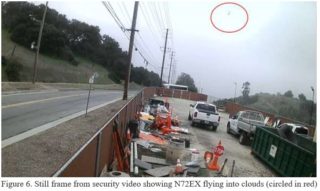From the outset it looked to me as though the Kobe Bryant crash was a simple case of “continued VFR into IMC” — a crash caused by a pilot wandering into clouds and fog and losing control of the helicopter and crashing. The NTSB’s update seems to confirm just that. Here are the four important points from the update:
A photograph of the helicopter seems to show it entering clouds.
The pilot was on a visual flight rules (or “VFR”) flight. On a VFR flight, the pilot is supposed to control the helicopter by looking out the window rather than by looking at the helicopter’s instruments. So, on a VFR flight, the pilot must stay out of fog and clouds. Yet the photo shows Kobe’s helicopter flying into clouds (“IMC,” or “instrument meteorological conditions”), or at least flying on the ragged edge of acceptable visibility.
helicopter’s instruments. So, on a VFR flight, the pilot must stay out of fog and clouds. Yet the photo shows Kobe’s helicopter flying into clouds (“IMC,” or “instrument meteorological conditions”), or at least flying on the ragged edge of acceptable visibility.
The pilot’s last communication is consistent with his being inside the clouds and trying to escape them.
The last communication air traffic control received from the pilot was that he was climbing to 4000 feet — well above his cruising altitude. That suggests that the pilot was attempting to get out of the foggy conditions by climbing above them.
The aircraft’s flight path was consistent with the pilot’s losing control of the helicopter while in the clouds.
The update notes that:
the aircraft was climbing along a course aligned with Highway 101. . . reached 2,300 feet msl (approximately 1,500 feet above the highway, which lies below the surrounding terrain) and began a left turn. Eight seconds later, the aircraft began descending and the left turn continued. The descent rate increased to over 4,000 feet per minute (fpm), ground speed reached 160 knots.”
Translation: the helicopter climbed, then started a turn, then suddenly went out of control and tumbled out of the sky.
Nothing was mechanically wrong with the helicopter.
The update notes that there didn’t appear to be anything wrong with the helicopter and it was producing power at impact.
In short, the crash appears to be a classic case of loss of control following improper VFR flight into IMC.
Some folks are saying that the helicopter should have had a terrain awareness warning system to let the pilot know where the hillside was. It wouldn’t have helped. The pilot crashed because he flew into IMC and lost control. Not because he hit a hillside that he could not see.



